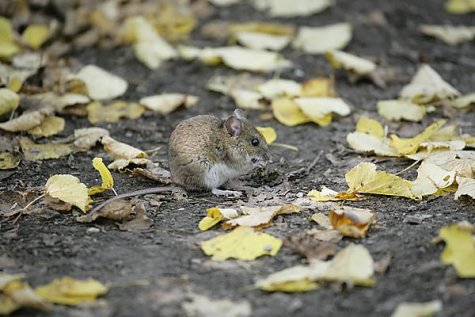Mischief-makers in the summerhouse
Photo: Arne Ader
Translation: Liis
ellow-necked mouse in falling leaves
| Yellow-necked mouse |
Kaelushiir
|
Apodemus flavicollis |
| House mouse |
Koduhiir
|
Mus musculus |
The first period of autumn cold has been here and there was even a light cover of snow. The cold and wet „dog weather“ makes rodents search for more pleasant shelter, and dry and easily conquered wooden buildings are to their liking.
Whom of the mischief-makers do we have to deal with? It isn’t difficult to find out from the smell and the traces of their activities. If a strong mouse smell hits your nose, then there are house mice; the urine of the yellow-necked mice doesn’t leave a particularly strong smell.
Let us see at the other evidence. House mice chew and nibble at nearly everything in the place. The doings of the yellow-necked mice are obvious and irritating; we have to do with a very skilful climber and a rodent for whom it isn’t enough to eat its fill from the oatmeal bag; food has to be carried away to a hiding place. Such stores can be found in the pockets of coats, under a pillow, or in a lined rubber boot. And a new entrance to the pocket of your jacket, with some forgotten acorns, has appeared ... The activities of the yellow-necked mice can be heard quite well at night. In smaller buildings the house mice are quickly driven off from the territory. Rodents don’t consider co-existence to be a proper way of living.
There is nothing to be done about it, traps and poison must be set out. When a mouse has been trapped the species can be determined from its looks. A mouse that has died from poison shouldn’t be thrown out in nature; if there is a fire in the kitchen range or the fireplace it can be cremated. The poison shouldn’t be left to be carried on to the next „user“.
The fur of the house mouse is mouse grey, the belly is somewhat paler and the tail shorter than the body.
The fur on the back of the yellow-necked mouse is clearly brown, the belly white, a yellow collar at the neck is individually different. As a good climber it has strong and big hind legs, the tail is long or equal in length to the body.
Other species are much more rare in living houses.









